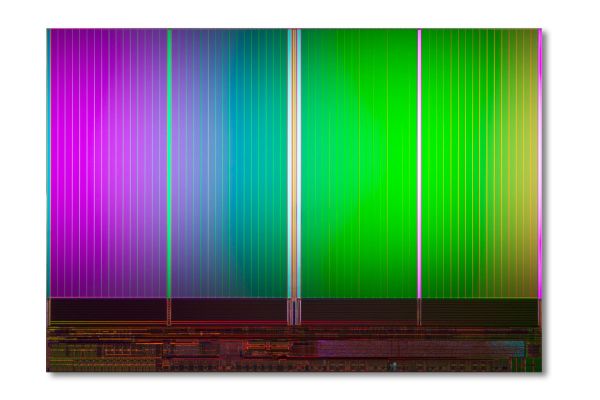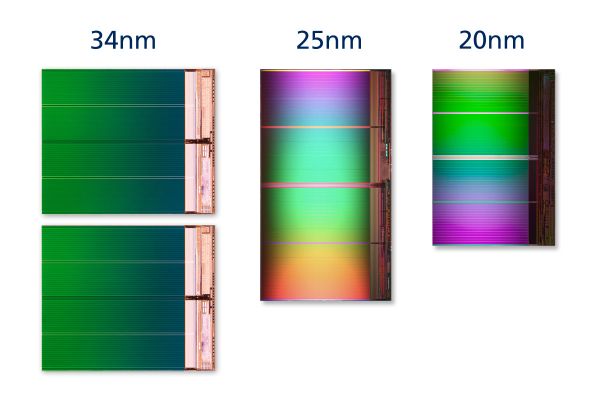Intel & Micron Announce First 20nm MLC NAND Flash for Use in SSDs
by Anand Lal Shimpi on April 14, 2011 11:49 AM EST
We just started testing SSDs based on IMFT 25nm NAND Flash and look at what Intel/Micron just announced? The first 8GB MLC NAND device built on a 20nm process. This is obviously an announcement of pre-production silicon, it’ll take IMFT until the second half of this year (at least) to start shipping production quality 20nm NAND.

IMFT 20nm 8GB NAND, 118mm2
At 50nm IMFT NAND was good for 10,000 program/erase cycles (rated, not actual). The move to 34nm dropped that to 3000 - 5000 program erase cycles, a value that was maintained with the move to 25nm. I asked Micron how long NAND will last at 20nm and was told that p/e cycles are comparable to where 25nm was at a similar point in its development cycle. Micron expects quality to ramp over time and ultimately hit a similar point to existing 25nm NAND, which is good for controller manufacturers as it means any ECC/NAND redundancy efforts they have already implemented should support the new 20nm product.
An 8GB 2-bit-per-cell MLC NAND device built at 20nm has a die area of 118mm2, down from 167mm2 at 25nm. A single 8GB NAND device wasn’t built at 34nm.
IMFT is on a 15 - 18 month process cadence, meaning this transition was of course planned for in advance. The first 20nm NAND is being manufactured at the IMFT Fab in Lehi, Utah, which is currently producing 25nm NAND. Some equipment upgrades are necessary to support 20nm. IMFT will also transition its fabs in Manassas, VA and Singapore to 20nm at a later point.
For consumers there’s an obvious win. We need smaller transistor geometries to reduce the cost of NAND, which ultimately reduces the cost of SSDs. The days of 50% annual price reductions are over however, expect to see a conservative 20 - 30% drop in price for SSDs that use 20nm NAND over 25nm NAND.











38 Comments
View All Comments
krumme - Thursday, April 14, 2011 - link
Low cost ssd, is far more important for consumers than the next fancy cpu with record breaking speedHope reliability will improve for all
formulav8 - Thursday, April 14, 2011 - link
Well 25nm flash was supposed to noticably lower ssd prices. I wouldn't have my hopes up with 20nm. Maybe after 25nm prcoess is mature enough then the prices may lower...Daemas - Thursday, April 14, 2011 - link
the 25nm process will never mature enough because they'll just switch to 20nm the second it comes out.TypeS - Thursday, April 14, 2011 - link
Honestly, SSDs will never see the price point/GB that HDDs enjoy and consumers need to stop waiting for that day. I've worked a brick and mortar computer for sometime now and I keep hearing customers they will wait for the prices to drop. I think some consumers want to replace their HDD storage with SSDs all together, which I don't think will happen for a long time to come (and it won't be by SSDs). You honestly only need a 60/80GB (now 160GB with 25nm) for most Windows installations. Hoping for sub $50 1TB SSDs is like hoping for the US to solve it's ballooning debt.vol7ron - Thursday, April 14, 2011 - link
Normally I'd agree, but in this case I have to disagree.The difference between 25nm and 20nm is not much. My guess is that the rated 3000-5000 P/E cycles was a little conservative for 25nm on purpose, for the shear fact that the 20nm will actually perform at that spec, thus avoiding a marketing dilemma.
I also don't see them doing away with the 25nm, just because 20nm will be out. I don't know the numbers off hand, but I'm not sure that they've made enough profit to pay off R&D. Instead, I could see Intel using their 25nm in larger capacity drives.
Up to this point all we've seen is the leading consumer disks either provide a better controller, or minimized fabrication to increase performance. These are both the easy way out because they're going with what they know and what the market knows. I am still wanting to see something more creative. More chips per board, faster DRAM, faster controllers.
In essence, I view each SSD card like a mini computer w/in the computer. You have your controller (the cpu), the RAM, and each NAND (individual HDs in a RAID-0). Bottlenecks do exist internally - how much? I dont know - but throwing more NAND chips into the array or using faster memory will improve speed.
It may cost more, but the $/GB will decrease the more NAND chips you slap on it. And, of course, using more NAND in the devices, will actually decrease the market price. Yes, I'd like to have 2TB SSD for everything, and 5-10TB of HDD for backups and longterm media (DVR).
------------------------------
Final note: I've said it every other time, so I might as well say it now; Intel is playing the same game they played with their CPUs, getting every ounce of $$ out of their consumers pockets for marginal updates. They need to combine their wear-leveling with some decent compression algorithms to have the ultimate SSD. I don't really know much about how either are applied, but I assume they would play nice w/ each other. It might involve adding a few more capacitors to ensure power-outage integrity, but c'mon.
Exelius - Monday, April 18, 2011 - link
Intel doesn't have anywhere near the pricing power in the SSD market that they have in the CPU market. NAND is effectively a commodity product, Intel is a big player but they're certainly not the only one.Jedi2155 - Friday, April 15, 2011 - link
Just because a process technology is released does not mean the old equipment goes out to the pasture. Rather they are relegated to other less size critical items to manufacture like the chipset or other semiconductors. I wouldn't be surprised if there were still a ton of 0.25 micron (250 nm) or larger products out there.claytontullos - Thursday, April 14, 2011 - link
The intel 320 series did produce lower ssd prices, but only for 160gb sizes and up. The 160gb 320 series can be found for $299 - whereas the x25m 160gb was $399.taltamir - Thursday, April 14, 2011 - link
don't confuse "cost to manufacture" and "cost to buy"... even though cost to manufacture went down, cost to buy did not because there is simply too much demand and not enough production.yioemolsdow - Wednesday, April 20, 2011 - link
★∵☆.◢◣ ◢◣
◢■■◣ ◢■■◣
◢■■■■■■■■■◣
◢■■■╭~~*╮((((( ■■■◣
◥■■/( '-' ) (' .' ) ■■■◤
◥■■■/■ ..../■ ■■◤
◥■■■■■◤ jordan air max oakland raiders $34a€“39;
◥■■■◤
◥■◤ Christan Audigier BIKINI JACKET $25;
▼
\ Ed Hardy AF JUICY POLO Bikini $25;
\
\ gstar coogi evisu true jeans $35;
\
\ gstar coogi evisu true jeans $35;
\
\ coogi DG edhardy gucci t-shirts $18;
● \ ●
《 》 》》
》 《
_?▂▃▄▅▆▇███▇▆▅▄▃▂
^__^:====( www etradinglife com )======